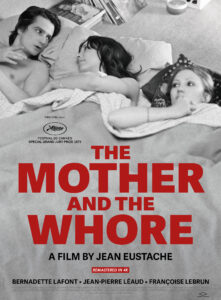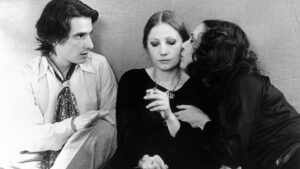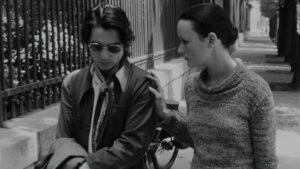“The Mother and the Whore” – Portrait of the 68’ Rebels

Title: “The Mother and the Whore”
Release Date: 1973
Director: Jean Eustache
Cast: Jean-Pierre Léaud, Françoise Lebrun, Bernadette Lafont
“The Mother and the Whore” by Jean Eustache is a scandalous film that was considered the most faithful portrait of French bohemianism of the late 1960s. Painfully honest, sometimes brutal and sometimes poetic, the four-hour picture captures the rebellion of the younger generation against traditional morality and the established social order. The story of a man simultaneously involved with two women is a provocative play with authentic threads from the director’s life, as well as a mirror of the collapse of the revolutionary myths of ’68. It’s also a story that foreshadows tragic events in Eustache’s personal biography. After all, shortly after the premiere, his partner portrayed in the film as “mom” committed suicide, and eight years later the director himself did so as well.
“The Mother and the Whore” – a film like life
“The Mother and the Whore” is a film that formally was supposed to reproduce the authentic current of life, hence the extremely long, nearly four-hour material, and the lack of a clear plot. The main protagonist of the picture is about thirty-year-old Alexandre (played by Jean-Pierre Léaud, known for his portrayal of a rebellious teenager in “400 Bats”), an out-of-work intelligent man who is supported by his partner Marie (Bernadette Lafont), a boutique owner. Alexandre one day meets a Polish-born nurse Veronica (Françoise Lebrun), with whom he soon enters into a sexual relationship. He not only does not hide his affair from Marie, but even brings his lover to her apartment to spend the night as a threesome. At the same time, the man tries to regain the affection of his former girlfriend, who, disappointed in her relationship with the unstable Alexander, marries another.
Although Marie seems to accept her partner’s behavior, she herself does not find understanding in him when she invites her former lover to the party. Embittered by the whole situation, she also tries to commit suicide by swallowing a vial of sleeping pills, but Alexandre saves her from this step by provoking vomiting. Eventually Marie and Veronica become friends, and during the alcoholic intoxication the nurse reveals her hidden fears and desires to both of them. It turns out that for her there is nothing more beautiful than “to fuck the man you love” and have a child with him. In the evening, Alexandre escorts Veronica to her humble servant’s house, and she hurls insults at him while claiming that she is pregnant with him. In the final scene, the woman vomits, ordering her lover to turn away.

“The Mother and the Whore” – the twilight of the 1960s contestation
The movie “The Mother and the Whore” is set several years after the events of May 1968 and documents this time, so to speak, in statu nascendi. It’s a period when the protest movements are dying out, and the young rebels are entering maturity and becoming part of the system they previously denied. Alxandre recalls this time as follows: “We had the Cultural Revolution, the Rolling Stones, May 1968, the Black Panthers, the Palestinians, the underground, and then nothing for the last two or three years.” The man is one of the last heroes of this rebellion, and his ostentatious disregard for traditional morality gives the impression of outdated posturing.
Alexandre gives the impression of a big spoiled child, unaware of the consequences of his behavior. For free love unexpectedly leads astray, and women begin to grasp this truth much more quickly than their lover. One abandons Alexandre, has an abortion and marries a stable man. While the other two, the titular “mom” and “whore,” mock the masculinity of the protagonist, who pushes through life with the help of his “kettle bill.”
In Eustache’s film, it’s the women who lead the “real life”: a teacher, a nurse, a boutique owner – all earning their keep and, despite appearances, standing firmly on the ground. He, meanwhile, is a lightweight and a dreamer trapped in the realm of his own dreams, financially exploiting his female partners. Extremely significant in the context of women’s vision of the world seems to be Veronica’s seven-minute monologue at the end of the film “The Mother and the Whore.” It constitutes, so to speak, the climax, when the heroine exposes her true motivations, confessing that, in fact, instead of sexual freedom, she dreams of love and a child. Interestingly, the hero promises to marry her.

Therefore, it can be said that Eustache’s film is a portrait of a generation and, at the same time, an honest to goodness display of the collapse of revolutionary myths. This is particularly emphasized by the symbolic motif of female characters vomiting. In the movie, both Marie – tired of the constant game of commitment and repulsion – and the drunken Veronica vomit. This seems to be a sign of exaggeration and literal disgust with outdated ideas, but also of maximum authenticity in portraying the spirit of contestation of the 1960s. There is no embellishment and misrepresentation, instead there is naturalism: the truth itself, including with its ugly face. One can even say that the whole film gives the impression of a failed work, with hours of idle and tiresome intellectual disputes in order to reflect the fiasco of the ’68 revolution.
“The Mother and the Whore” – a provocative game with reality
The new-wave postulate of creating cinema close to reality is realized by Eustache in “The Mother and the Whore” not only with a four-hour screening capturing the stream of life, but also with low-budget shooting of scenes in apartments and cafes. Most significant, however, is the balancing act between film and truth. Namely, the main character resembles the director, and the role of Veronica was played by his mistress at the time, Françoise Lebrun. Interestingly, at the time Eustache was simultaneously involved with Catherine, who was the prototype of the film’s Marie. Catherine committed suicide a few days after seeing the film. On the other hand, the director, extremely unappreciated by critics and deprived of the means to make films, shot himself in his Paris apartment in 1981….
Literature:
„Kino epoki nowofalowej”, pod red. T. Lubelskiego, I. Sowińskiej i R. Syski, Kraków 2015.
A.Garbicz, „Kino – wehikuł magiczny. Podróż czwarta: 1967 – 1973, Kraków 2000.

